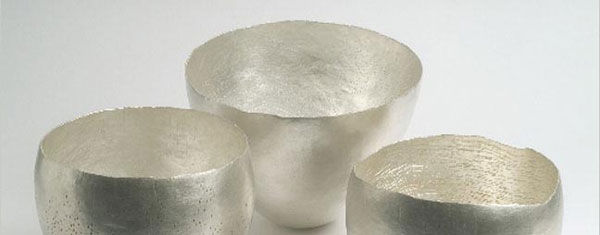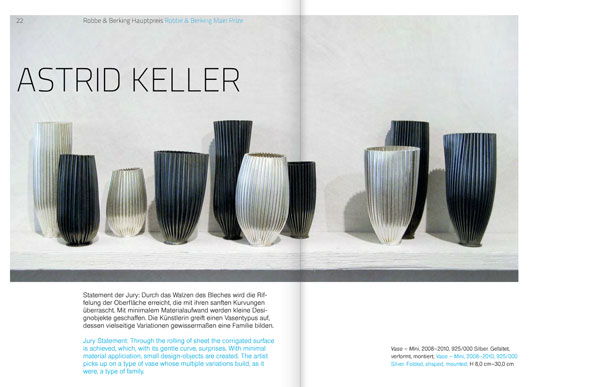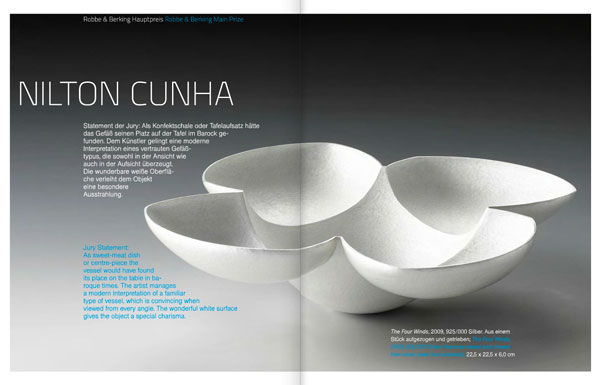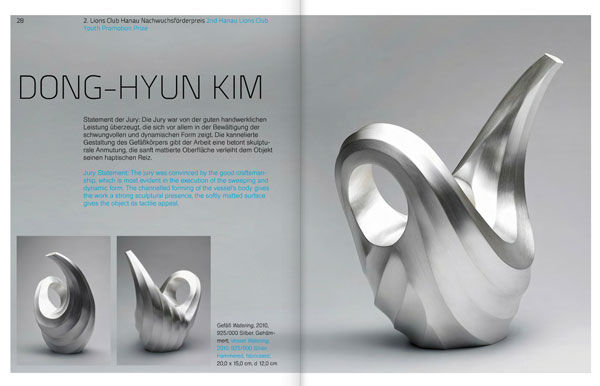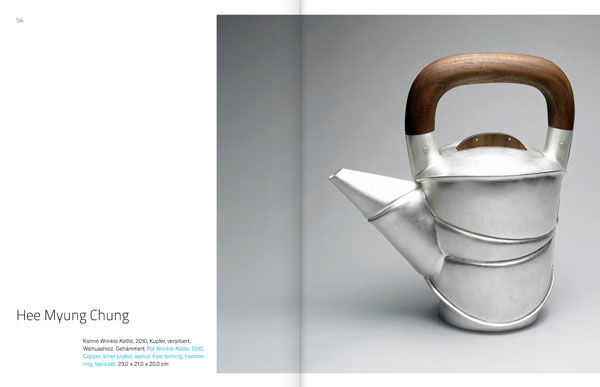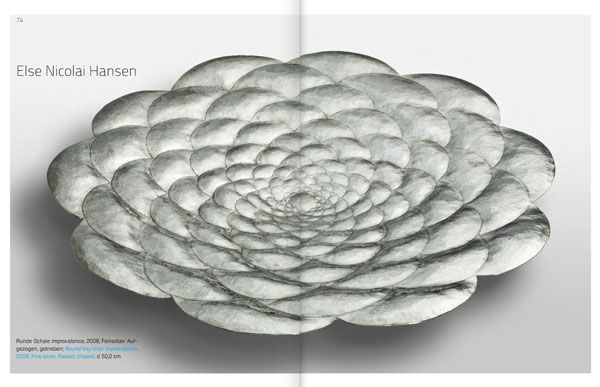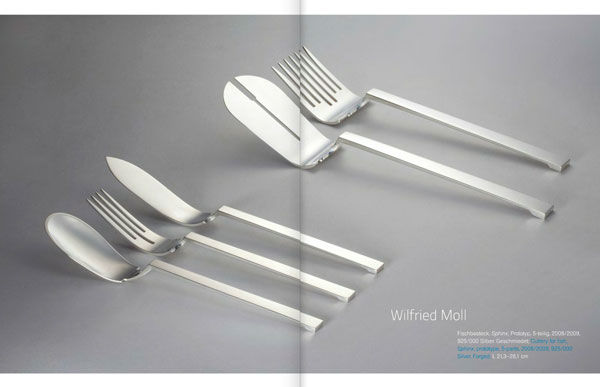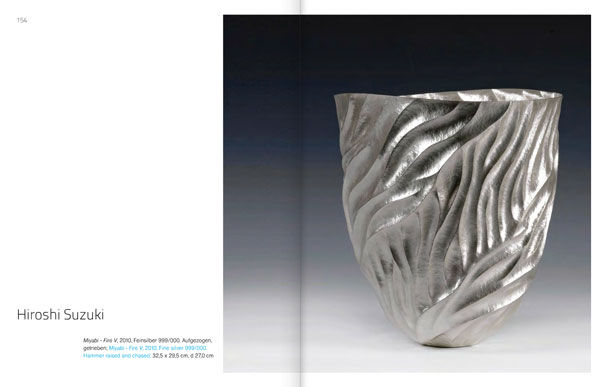Silver Triennial International – 16th Worldwide Competition
 Preview post
Article by Martin Gibson – @embody3d @martingibson – 18.05.2011
Preview post
Article by Martin Gibson – @embody3d @martingibson – 18.05.2011
One of the great things about Embody 3D is that sometimes we receive books that we don’t anticipate, but are just full of surprise and intrigue. Silver Triennial International – 16th Worldwide Competition by Christianne Weber-Stöber and published by Arnoldsche is one of these titles. Put simply, Silver Triennial International showcases the best silversmithing from all over the world. We often sometimes forget that such traditional arts and craft niches still exist and are flourishing in this age of mass production and tooling. It seems that such a time consuming, expensive and environmentally unsustainable craft still is able to persevere through such a difficult economic climate. I guess someone has to make objects for the rich and famous!
The Association of Goldsmith Arts has convened every 3 years to exhibit some of these hidden silver gems. However in 1992 and in 2010 (the 16th triennial) the Association decided to hold an international competition with a total of 158 artists participating from 20 countries including Australia, Belgium, Canada, Czech Republic, Denmark, Germany, Finland, Greece, Great Britain, Hungary, Italy, Japan, New Zealand, the Netherlands, Poland, Sweden, Switzerland, South Korea, Taiwan and the USA. A specialist jury was selected including Dr. Stephan Demmrich, Dr. Rudiger Joppien, Beate Leonards to determine 83 participants for a touring exhibition. This book, Silver Triennial International documents these exhibition pieces including the grand prize winners.
Some of the categories of work featured in the Silver Triennial International include pouring vessels, bowls, candle-stands, vases, cutlery and free objects. But more specifically these every-day products include beakers, water jugs, tea and coffee pots, milk and sugar sets, bowls, salt and pepper sets and cutlery. Because of the standard fit and finish of silverware, as you flick through each page the designs really become a study of highly technical construction, powerful aesthetic detail and purposeful/experimental design. It really is a sight to behold.
The designs feature a variety of both modern and traditional construction techniques. Take for instance Rob Thalen’s Bowl 0610 and Explosive that push the boundaries of material engineering. Another standout is Andreas Decker’s sweeping platter design that portrays an irregular and indefinable landscape which is accentuated by the surface texture of the design. Some artists have a more personal inspiration behind their work. For example, Eva Reidel devotes her work to Jewish ritual objects of the bowl and jug by using a very time consuming metal works technique called chasing which allows a thin sheet to have the durability to become a stable vessel.
All the designs are just breathtaking! Hee Myung Chung’s kettle completely won me over to becoming a silversmith fan. This jug is truly alive in detail, the finishing is so ornate, yet the design is so modern and timeless. Because the processes are so time consuming and their attention to detail makes a royal wedding planner seem like a klutz, the designs are very well thought out and justified. Each design is like a sculpture, with every hole, extrusion, bend, reflection and engraving being deliberately considered. There are some works that mix silver with alternate materials like wood, fabric and glass which adds a whole new dimension to the traditional craft. However, any industrial designers whether working in the silver arena or not can seek inspiration as many of the designs in essence could be inspired into plastics and wood.
This book really does feel like a museum piece as the collection is a touring exhibition and has been photographed in a consistent studio environment that pays homage to the objects form, rather than dressing it up by elaborate and often distracting backgrounds. The photographs are the best if not equal to the best I have witnessed on the printed page. Not only is the print quality and photo resolution maximised, the way light is utilised to best serve each design has once again been very deliberate and satisfying.
Silver Triennial International is successful in bringing awareness to this millennia old craft that is still breathing new talent from education institutions in Germany like Staatliche Zeichen-akademie in Hanau, the Hochschule in Hildesheim, the schools in Pforzheim or Kaufbeuren-Neugablonz or the Akademie deer Bildenden Kunste in Nurnberg. Not to mention other schools in Belgium, Great Britain, Japan, South Korea and Taiwan. Titles like this are important for a relatively small community of master craftsman in strengthening their allegiance and for public awareness about their skills and product offerings. If I had to make any improvements to this book it would be that it would be nice if we could hear the voice behind the designs. To hear the artists opinion about their inspiration, challenges or thoughts and ideas about their creations. I am sure as well the artists would probably welcome this opportunity as these 1-off objects so often have interesting stories behind them. Another enhancement to Silver Triennial International would be to perhaps show work in development photos in conjunction with the studio albums. I think this would really highlight the great deal of manual labour and character that had to go into such small and delicate objects,
The book contains two translations, both English and German, but thankfully the book designer has made it easy to dissect the two by colour-coding the paragraphs. This book is right on the verge of being a 4.
[rating:3.5]


